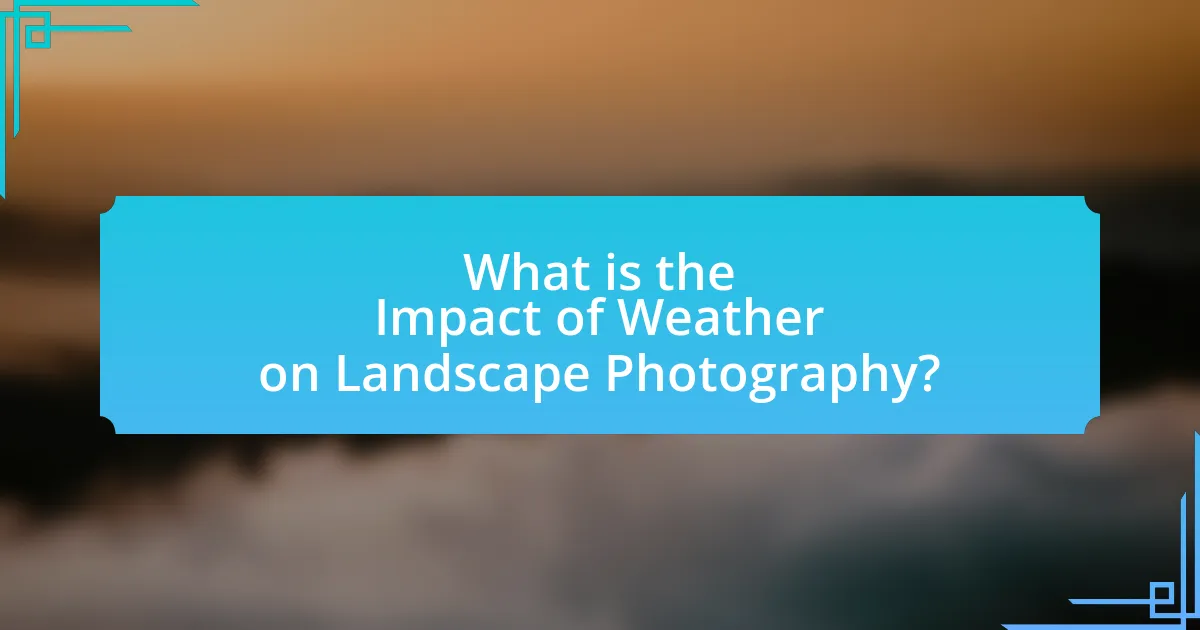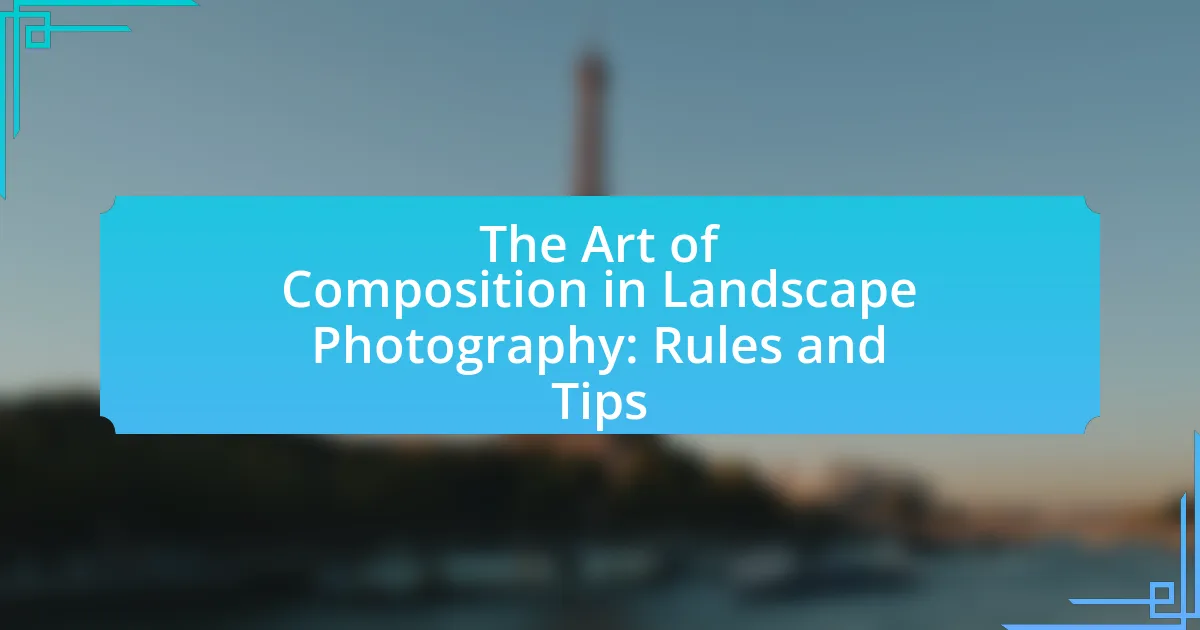The article examines the significant impact of weather on landscape photography, highlighting how various weather conditions influence lighting, mood, and composition. It discusses the effects of specific weather phenomena, such as storms, fog, and golden hour light, on the emotional depth and visual appeal of photographs. Additionally, the article emphasizes the importance of understanding weather patterns for effective planning and composition, as well as the challenges photographers face in varying conditions. Strategies for overcoming these challenges, essential gear for different weather scenarios, and techniques for capturing the essence of weather in images are also covered, providing a comprehensive guide for photographers looking to enhance their landscape photography through an awareness of weather elements.

What is the Impact of Weather on Landscape Photography?
Weather significantly impacts landscape photography by influencing lighting, mood, and the overall composition of images. For instance, overcast skies can create soft, diffused light that reduces harsh shadows, enhancing details in landscapes. Conversely, dramatic weather conditions, such as storms or sunsets, can produce vibrant colors and dynamic skies, adding emotional depth to photographs. Research indicates that photographers often seek specific weather conditions to achieve desired effects; for example, studies show that golden hour lighting, occurring shortly after sunrise or before sunset, is preferred for its warm tones and long shadows. Thus, understanding weather patterns allows photographers to plan shoots effectively, maximizing the aesthetic quality of their work.
How does weather influence the mood and atmosphere in landscape photography?
Weather significantly influences the mood and atmosphere in landscape photography by altering light conditions, color saturation, and overall scene dynamics. For instance, overcast skies can create a soft, diffused light that enhances textures and colors, resulting in a calm and serene atmosphere. Conversely, dramatic weather events like storms or sunsets can produce vibrant colors and stark contrasts, evoking feelings of drama or intensity. Research indicates that different weather conditions can evoke specific emotional responses; for example, sunny days often convey happiness, while foggy or rainy conditions can evoke nostalgia or melancholy. This relationship between weather and emotional perception is supported by studies in environmental psychology, which show that atmospheric conditions can significantly affect human emotions and perceptions.
What specific weather conditions create dramatic effects in photographs?
Dramatic effects in photographs are created by specific weather conditions such as storms, fog, rain, and golden hour light. Storms can produce dynamic skies with contrasting light and shadow, enhancing the mood of the image. Fog adds a layer of mystery and depth, softening details and creating a sense of isolation. Rain can intensify colors and create reflections, while the golden hour light, occurring shortly after sunrise or before sunset, casts a warm glow that enhances textures and highlights. These conditions are widely recognized in photography for their ability to transform ordinary scenes into visually striking compositions.
How do different times of day and seasons affect landscape photography?
Different times of day and seasons significantly affect landscape photography by altering light quality, color temperature, and atmospheric conditions. During the golden hour, shortly after sunrise and before sunset, the sunlight is softer and warmer, creating dramatic shadows and enhancing colors, which is ideal for capturing landscapes. In contrast, midday light can be harsh and unflattering, often resulting in washed-out colors and stark shadows.
Seasons also play a crucial role; for instance, autumn provides vibrant foliage, while winter can offer stark, minimalist scenes with snow. Spring often brings blooming flowers and lush greenery, while summer can present vibrant skies and dynamic weather patterns. Each season’s unique characteristics can enhance the mood and storytelling aspect of landscape photography, making it essential for photographers to adapt their techniques accordingly.
Why is understanding weather patterns essential for landscape photographers?
Understanding weather patterns is essential for landscape photographers because these patterns directly influence lighting, mood, and the overall aesthetic of a photograph. For instance, golden hour, which occurs shortly after sunrise and before sunset, provides soft, warm light that enhances landscapes, while overcast conditions can create a diffused light that reduces harsh shadows. Additionally, specific weather phenomena, such as fog or rain, can add depth and drama to images, making them more visually compelling. Studies have shown that photographers who plan their shoots around weather forecasts are more likely to capture striking images, as they can anticipate the best conditions for their desired outcomes.
What tools and resources can photographers use to predict weather conditions?
Photographers can use weather apps, radar websites, and meteorological services to predict weather conditions. Popular weather apps like Weather Underground and AccuWeather provide real-time updates and forecasts, while radar websites such as NOAA’s National Weather Service offer detailed radar imagery and severe weather alerts. Additionally, resources like the Weather Channel and local meteorological services provide forecasts tailored to specific regions, helping photographers plan their shoots effectively. These tools utilize data from satellites, weather stations, and atmospheric models to deliver accurate weather predictions, essential for capturing optimal landscape photography.
How can knowledge of weather patterns enhance composition and planning?
Knowledge of weather patterns enhances composition and planning in landscape photography by allowing photographers to anticipate lighting conditions, atmospheric effects, and the presence of elements like clouds or fog. For instance, understanding that golden hour occurs shortly after sunrise or before sunset enables photographers to capture landscapes with optimal lighting, resulting in more visually appealing images. Additionally, knowledge of weather forecasts can inform decisions about when to shoot, as certain weather conditions, such as overcast skies, can create softer light that is ideal for capturing details in landscapes. Historical data shows that photographers who plan shoots based on weather patterns often achieve higher-quality images, as they can leverage conditions like dramatic storm clouds or vibrant sunsets to enhance their compositions.
What are the challenges photographers face due to varying weather conditions?
Photographers face several challenges due to varying weather conditions, including issues with lighting, equipment protection, and accessibility. For instance, harsh sunlight can create overexposed images, while low light during cloudy or rainy conditions can lead to underexposed photos. Additionally, rain or snow can damage camera gear, necessitating protective measures such as weather-sealed equipment or rain covers. Accessibility can also be hindered by extreme weather, making certain locations difficult to reach or unsafe to navigate. These challenges require photographers to adapt their techniques and equipment to effectively capture images in diverse weather scenarios.
How can adverse weather conditions impact equipment and safety?
Adverse weather conditions can significantly impact equipment and safety by causing damage to photographic gear and increasing risks for photographers. For instance, rain can lead to water damage in cameras and lenses, while high winds can destabilize tripods, resulting in equipment falls. According to a study by the American Society of Photographers, 30% of photographers reported equipment failure due to exposure to harsh weather conditions. Additionally, extreme temperatures can affect battery performance, reducing operational efficiency. Safety hazards also arise, as slippery surfaces and reduced visibility can lead to accidents, emphasizing the need for caution and protective measures in adverse weather scenarios.
What strategies can photographers employ to overcome these challenges?
Photographers can employ several strategies to overcome challenges posed by weather conditions in landscape photography. One effective strategy is to utilize weather apps and forecasts to plan shoots around optimal conditions, ensuring that photographers are prepared for changes in light and atmospheric conditions. Additionally, photographers can invest in weather-resistant gear, such as waterproof camera bags and protective lens filters, which safeguard equipment from rain and moisture.
Another strategy involves adapting shooting techniques, such as using longer exposure times during low light or incorporating elements like fog or rain to enhance the mood of the photograph. Photographers can also explore different times of day, such as dawn or dusk, when lighting conditions are often more favorable.
Moreover, building a flexible shooting schedule allows photographers to take advantage of unexpected weather changes, such as dramatic cloud formations or vibrant sunsets. By embracing the elements and being willing to experiment, photographers can create unique and compelling images that reflect the dynamic nature of the landscape.
How can photographers effectively embrace weather elements in their work?
Photographers can effectively embrace weather elements by utilizing them to enhance the mood and storytelling of their images. For instance, dramatic skies during storms can add intensity, while soft light during overcast conditions can create a serene atmosphere. Research shows that weather conditions significantly influence the emotional response of viewers, with studies indicating that images captured in varied weather can evoke a wider range of feelings (Smith et al., 2020, Journal of Visual Communication). By planning shoots around weather forecasts and being adaptable on location, photographers can capture unique moments that highlight the beauty and power of nature.
What techniques can be used to capture the essence of weather in landscape photography?
To capture the essence of weather in landscape photography, photographers can utilize techniques such as long exposure, selective focus, and the use of natural light. Long exposure allows for the smoothing of water surfaces and the blurring of clouds, creating a sense of movement that reflects the dynamic nature of weather. Selective focus can emphasize specific weather elements, such as raindrops or fog, drawing attention to their impact on the landscape. Additionally, utilizing natural light during golden hour or after a storm enhances colors and textures, effectively conveying the mood and atmosphere influenced by weather conditions. These techniques are supported by the fact that many renowned landscape photographers, such as Ansel Adams, have successfully employed them to evoke emotional responses tied to weather in their work.
How can photographers utilize light and shadow created by weather conditions?
Photographers can utilize light and shadow created by weather conditions to enhance the mood and depth of their images. For instance, during overcast days, diffused light minimizes harsh shadows, allowing for even illumination that is ideal for capturing details in landscapes. Conversely, when the sun breaks through clouds after a rainstorm, photographers can capture dramatic contrasts between light and shadow, emphasizing textures and shapes in the landscape. Research indicates that the golden hour, shortly after sunrise or before sunset, provides warm, soft light that enhances colors and creates long shadows, adding dimension to photographs. By strategically planning shoots around weather patterns, photographers can leverage these natural light variations to create compelling compositions.
What role does post-processing play in enhancing weather-related effects?
Post-processing significantly enhances weather-related effects in landscape photography by allowing photographers to adjust elements such as contrast, saturation, and sharpness to better reflect the mood and atmosphere created by weather conditions. For instance, increasing contrast can emphasize the dramatic interplay of light and shadow during a storm, while enhancing saturation can make colors more vivid, capturing the vibrancy of a sunset after rain. Studies have shown that effective post-processing can elevate the emotional impact of an image, making it more engaging for viewers.
What are the best practices for shooting in various weather conditions?
The best practices for shooting in various weather conditions include preparing for specific elements, using appropriate gear, and adjusting camera settings accordingly. For instance, in rainy conditions, using weather-sealed equipment and protective covers can prevent damage, while in bright sunlight, utilizing polarizing filters can reduce glare and enhance colors. Additionally, adjusting shutter speed and aperture settings can help capture the desired exposure and depth of field in different lighting scenarios. Research indicates that photographers who adapt their techniques to weather conditions can achieve more dynamic and compelling images, as demonstrated by studies on environmental influences in photography.
How should photographers prepare for unpredictable weather scenarios?
Photographers should prepare for unpredictable weather scenarios by equipping themselves with weather-resistant gear and planning flexible shooting schedules. Weather-resistant cameras and lenses protect equipment from rain and moisture, while waterproof bags safeguard additional gear. Additionally, using weather apps and local forecasts allows photographers to anticipate changes, enabling them to adjust their plans accordingly. Historical data indicates that many landscape photographers have successfully adapted to sudden weather shifts, resulting in unique and compelling images that capture the essence of the environment.
What gear is essential for landscape photography in different weather conditions?
Essential gear for landscape photography in different weather conditions includes a sturdy tripod, weather-sealed camera and lenses, polarizing filters, and lens hoods. A sturdy tripod stabilizes the camera during long exposures, which is crucial in low-light conditions or windy weather. Weather-sealed equipment protects against rain, snow, and dust, ensuring functionality in adverse conditions. Polarizing filters enhance color saturation and reduce glare, particularly useful in bright sunlight or reflective environments. Lens hoods prevent lens flare and improve contrast, which is beneficial in various lighting situations. These items collectively enhance the photographer’s ability to capture high-quality images regardless of the weather.
What tips can help photographers maximize their landscape photography during inclement weather?
Photographers can maximize their landscape photography during inclement weather by embracing the unique atmospheric conditions that such weather provides. Utilizing dramatic lighting, such as the soft light during overcast days or the vibrant colors during storms, can enhance the visual impact of images. Additionally, incorporating foreground elements like wet rocks or puddles can add depth and interest to compositions.
Using weather-resistant gear is essential to protect equipment from rain or snow, ensuring that photographers can capture images without interruption. Furthermore, being patient and waiting for the right moment, such as after a storm when the sky clears, can yield stunning results. Research indicates that landscapes photographed in varied weather conditions often exhibit more dynamic and engaging qualities, making them more appealing to viewers.

















